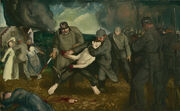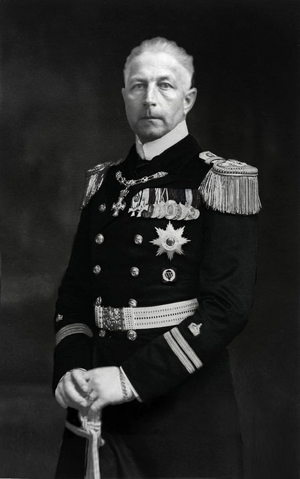| Lore | Paths |
Flanders-Wallonia, officially the Kingdom of Flanders-Wallonia, is a country in Western Europe. It is bordered by the Netherlands to the north, the German Empire to the east, and the Commune of France to the southwest. Formerly known as Belgium, it was an independent kingdom that participated in the Weltkrieg. Albert of Saxe-Coburg-Gotha led the country as King of the Belgians, but it was later dissolved in the Treaty of Versailles when the Kingdom of Flanders-Wallonia was established under the control of the German Empire.
History[]
Weltkrieg[]
At the beginning of the Weltkrieg, Belgium was officially a neutral power. However, early in the war, Germany invaded the country to execute the Schlieffen Plan - giving a justifiable cause that allowed the British Empire to declare war on Germany. The war in the West soon grinded down to a halt, giving into the infamous stalemate of trench warfare.

The Germans Arrive by George Bellows depicting the 1914 German atrocities in Belgium.
Under the command of King Albert himself, the Belgian army was the among the first to engage with the German armies during the Weltkrieg. The Belgian forces were able to stall their foes' advance towards France, a fact which had invoked the ire of the German Army. The Germans responded by savagely murdering Belgian civilians whom they accused of illegal sabotage.
Inspired by the speeches of Jules Destrée, German experts concluded that a federal state was the best option in order to reduce the contacts between Flemish and Walloons and avoid the creation of a unified resistance of all the population of the country. The first step of this process actually began during the Weltkrieg and was called the Flamenpolitik (Flemish politics). It consisted of the Flemish autonomist and independentist intellectual supports in order to enfeeble the Belgian unity.
In 1916, the Flamenpolitik was decided and subsequently begun. The University of Ghent was Flemishised so courses in French were stopped. The following year, the German occupation authorities created the Raad van Vlaanderen (Council of Flanders) in order to rule gain support from Flemish autonomist movements. At the same time, the country was divided administratively on a linguistic basis. The south of the province of Brabant was attached to Wallonia and Walloon ministries were installed in Namur while Flemish ones remained in Brussels. Even if an independent Flanders was initially considered, the fear that an independent Wallonia under French influence would isolate Flanders from Germany convinced the German government that a federal government with essential ministries being held in common, was the best course of action for the occupied nation.
With the fall of Paris, a few Belgian troops managed to evacuate with the British. However, it was too late, and the soldiers would soon return home to a broken and surrendered country.
Treaty of Versailles[]
Belgium was among the parties of the Treaty of Versailles that was officially signed on 6th November 1919 along with the representatives of the French, Luxembourgish and German nations. Parts of the treaty relevant to Belgium included:
- The destruction of French forts on the Belgian borders by the French forces;
- The Grand Duchy of Luxembourg would become a member of state of the German Empire;
- Belgian Luxembourg, the southern province of the Kingdom, would be “occupied” by the German Empire to "restore order to the region" and administered by Luxembourg proper;
- Luxembourg would also get to annex a strip of land including the Belgian city of Arel;
- The Kingdom of Belgium had to give unlimited access to its military installations and to the port of Antwerp to German forces;
- All Belgian institutions were to be remodeled to form a Flemish-Walloon Kingdom led by a German King; and
- The Belgian Congo was to be annexed and folded into Mittelafrika.
Interwar[]
Under the newly recently empowered Raad van Vlaanderen, Pieter Tack became the first chief of government and Adalbert von Hohenzollern, the Kaiser's third son, was inaugurated. But before the ceremony, a debate erupted about the nature of his royal title. Three options were possible:
- "King of Flanders and Wallonia" - a title based on territory;
- "King of the Flemish and the Walloons" - the popular solution since it was closest to "King of the Belgians"; and
- "Flemish and Walloon King" - the German solution to style it as a King with two adjectives.
The last option came with several difficulties because, quite obviously, Adalbert was neither Flemish nor Walloon. On the 17th of February 1922, Adalbert was solemnly established as King of Flanders and Wallonia. Contrary to other monarchic traditions there was no coronation, he swore an oath on the new constitution before the new parliament that was selected by the German authorities. In addition in order to gain support in the country, Adalbert converted to Catholicism. After all, the main Flemish slogan was AVV-VVK: Alles voor Vlaanderen, Vlaanderen voor Kristus (Everything for Flanders, Flanders for Christ).
In 1936, the buffer state of Flanders-Wallonia is approaching a boiling point, with the Flemish population wanting to join the neutral Netherlands, the nationalism of the Walloon population having turned to French-fashioned syndicalist views, and the population as a whole being tired of the German domination.
Politics[]
The federal structure of Flanders-Wallonia gives the states of Flanders and Wallonia a high degree of autonomy. The states are sovereign in areas such as taxation, budget, and they both have a sovereign police force. Matters concerning national defense, foreign policy, and other higher functions are decided by the Federal Government and the King.
In theory, Flanders-Wallonia is a Constitutional Monarchy. In practice, however, parliamentary control over the government is rather minimal and far from complete.
Insurrectionist forces[]
Political parties can only have legal status and participate in elections if they accept the post-Weltkrieg status quo such as the Hohenzollern Monarchy, membership in Mitteleuropa, etc. This limitation makes legal opposition parties stunted and ineffective. Moreover, the real oppositional forces in Flanders-Wallonia are illegal underground groups who are faced with constant persecution by the police and security services.
There are two main oppositional currents:
- The Belgian Nationalists and Monarchists, seeking to restore Belgium to its 1914 borders, with its throne held by "the only legitimate King of Belgium" - the exiled King Albert, who had lived in London from the end of the Weltkrieg until 1925, when he followed the British Royal Family in flight to Canada.
- The Syndicalists, seeking a Workers Revolution and the creation of a Socialist regime modeled on the Commune of France (to a lesser degree, on the Union of Britain).
Each of these two groups have their own special dates when demonstrations, protests, and (especially for the Syndicalists) strikes are held; inevitably being brutally suppressed. Syndicalists mark Mayday and the anniversary of the creation of the Commune of France, marching through the streets and singing the forbidden "Internationale"; the Nationalist Monarchists sing the equally forbidden "Brabançonne", pre-1914 Belgian anthem, on the anniversary of the 1830 Belgian Revolution against Dutch rule, and on the birthday of their exiled King.
Both are stronger in Wallonia (including the parts which are under temporary German military occupation) than in Flanders, where they ponder ways of rectifying this situation. Nationalists are subdivided into "Constitutionalists" who seek to restore the pre-1914 Unitary Belgian Constitution, and "Federalists" who support making liberated Belgium into a Federal State (though not necessarily on the pattern established by the pro-German regime). For their part the Syndicalists hedge about the crucial issue of whether they seek a Commune of Belgium or incorporation into the Commune of France, stating that this point would be decided by the people once the rule of the Germans and their Belgian Capitalist stooges have been swept away.
Though their aims are obviously incompatible, Nationalists and Syndicalists do cooperate on occasion - for example, in joint protests by political prisoners against harsh prison conditions.
Raad van Vlaanderen[]
As part of Flamenpolitik in 1916, the German occupation authorities created the Raad van Vlaanderen (Council of Flanders) order to gain support from Flemish autonomist movements. At the same time, the country was divided administratively on a linguistic basis.
With the Peace with Honour, the Raad van Vlaanderen became the basis of the new government, with some Walloons and French-speaking inhabitants of Brussels joining in order stifle their expressed concerns regarding lack of representation.
Leadership[]

S.K.H. Adalbert von Preußen, King of Flanders and Wallonia
King of Flanders-Wallonia: Adelbert
Prime Minister: Paul Van Zeeland
Minister of Foreign Affairs: Charles d'Aspremont-Lynden
Minister of Economy: Alexandre Galopin
Minister of Justice: Emiel Thiers
Head of the General Intelligence and Security Service: Robert de Foy
Minister of Defense and Chief of the Federal Forces: Adalbert
Commander in Chief of Federal Land Forces:
Commander in Chief of Federal Navy:
Commander in Chief of Federal Air Forces:
Economy[]
Flanders-Wallonia has a very healthy industrial base for such a small country with 15 civilian factories, 4 military factories, and 1 dockyard.
Military[]
The armed forces of Flanders-Wallonia are under the control of Germany, which guarantees the protection and safety of the country.
Army[]
The Federal Land Forces are comprised of three infantry divisions one cavalry division and a specialized bicycle division, the Chausseurs Ardennais.
[]
The Federal Air Forces are basically non-existent, with the German Luftstreitkräfte providing air cover for Flanders-Wallonia. The Federal Navy consists of two pre-war German dreadnoughts, one cruiser and six destroyers.
Foreign relations[]
Flanders-Wallonia is under the political, economic, and military authority of Germany and grants military access to German units. It is a member of Mitteleuropa and is considered the "Vanguard in the West", like the United Baltic Duchy in the east.
It has very good relations with Germany and other members of the Reichspakt as well as friendly relations with Austria-Hungary and Denmark. However, Flanders-Wallonia has explicit declared hostility against the Commune of France.
